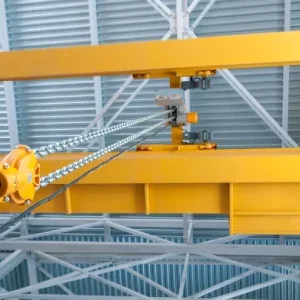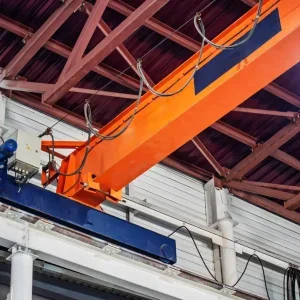Towards the end of 1999, as reported in Issue Seven of this magazine, KCI Konecranes reorganised its Standard Lifting Equipment operations to separate those parts of the business that used the Konecranes brand name and those that used other brands.
As a result, Verlinde of France, R&M Material Handling of the USA and SWF Krantechnik of Germany – three companies acquired by Konecranes in the recent past which had all retained their own brand names – were grouped together into a new division called Branded Products.
Public enemy
Behind this move lay the realisation that Konecranes was becoming the most unpopular company in the entire lifting industry (though not necessarily with customers, it should be stressed).
There were numerous reasons for this, and most of them were inevitable. The company was big and successful, which is always enough to lose a popularity contest. Added to this it was engaged, and still is, on an aggressive acquisition trail. Takeovers mean two things: new competitors and, almost always, redundancies. Even if there are no redundancies, there are often employees who leave as soon as they can find a new job because they are uncomfortable with the changed environment. So not only is there a growing number of companies from which Konecranes is winning business, the industry is littered with disaffected ex-Konecranes employees.
These reasons for unpopularity were largely irrelevant. They didn’t affect turnover, profitability or the share price.
But there was another reason why Konecranes had generated so much hostility. It was encompassing the entire supply chain of the lifting industry, being an engineering company, a crane builder, and a supplier of components. It was killing its own customers – those crane builders that bought components and lifting products from Konecranes companies. Now this was a problem that did threaten the bottom line.
The reorganisation of Standard Lifting Equipment and setting up the Branded Products Group was a recognition of the fact that attempts to find synergies between Verlinde/R&M/SWF and other Konecranes companies was faltering because “the Konecranes companies are often viewed as competitors by the SWF, R&M and Verlinde customers,” Konecranes president and chief executive officer Stig Gustavson explained at the time. “By distancing the Branded Products from the Konecranes brand, the companies will be in a better position to improve their customer relations.” This is the key motive for the reorganisation.
Other acquired companies, such as Trost & Hilterhaus and Kulicke in Germany and PRIM in Italy, are crane builders or service companies, and were integrated more comfortably into Konecranes’ operations. In contrast, Verlinde, R&M and SWF are equipment suppliers.
Enter Hoistek
The internal reorganisation moved forward another step in February 2000 when KCI Konecranes created Hoistek International as a parent company for the Branded Products Group. Hoistek is based in SWF’s offices in Heilbronn, Germany.
President of Hoistek is Pekka Heikkonen, who reports to the board of directors of KCI Corporation. Heikkonen had joined KCI as head of the Branded Products Group when it was established in 1999. Previously he had been president of Tamrock Construction in Finland and head of Sandvik Mining & Construction in the USA.
Hoistek’s website (www.hoistek.com) describes the company as “an independent group of hoist and crane component manufacturers. It markets overhead lifting equipment, components and services to independent crane builders, crane service companies, and industrial distributors. Multiple sales channels and multiple brands are used.”
Significantly, nowhere on the website is there any mention of the fact that Hoistek is part of the KCI Corporation. Nor does the name Hoistek appear on Konecranes’ website.
There is plenty of evidence to suggest that KCI Konecranes is trying to disguise the parentage of Verlinde, SWF and R&M to avoid losing business. And yet Konecranes is one of the strongest brand names in the lifting industry. How has it come to pass that it goes to such great lengths to hide the Konecranes name?
In fact, the impetus for hiding the Konecranes name has come from below rather than above. It was the sales and marketing staff at R&M, for example, who insisted that their email addresses should include rmhoist.com rather than konecranes.com. Similarly Verlinde employees’ email addresses are verlinde.com. They know that if they go knocking on doors of crane builders and say “Hi, I’m from KCI Konecranes – would you like to buy a hoist?”, they would not receive a sympathetic hearing.
In terms of distancing Verlinde, SWF and R&M from the parent company, KCI Konecranes Branded Products was no better a name than KCI Konecranes Standard Lifting Equipment. Hoistek, on the other, has the potential to be an effective ‘beard’, that disguises the relationship.
Camouflage
The branding camouflage goes beyond corporate identity to the products. The Hoistek companies sell marginally more hoists than Konecranes, though Konecranes’ sales bring in more revenue because it tends to sell more larger hoists. But often they are selling the same product.
Konecranes is currently putting a lot of marketing effort into promoting its new CXT hoist. Meanwhile Verlinde is promoting its new VT hoist, and SWF is promoting its new Nova. All of these are the same product, built to the same design using the same components, but badged differently, depending on who is trying to sell it.
SWF, Verlinde and Konecranes each have their own assembly lines for this product, but this is not to give them operational autonomy (they use the same components), but to spread the risk for the corporation. Risks include currency fluctuations and industrial action, either internal or external.
“We don’t want to put all our eggs in one basket,” says Gustavson.
R&M will soon start assembling the new hoist too. At present the Americans have to make do with assembling a version of the previous model.
One cannot even assume that a hoist badged as a Nova has been assembled in Germany. Each assembly line will help the others to manage the peaks and troughs in demand.
The extra cost involved in the duplication of marketing effort is presumably deemed justified by the fact that SWF and Verlinde sales staff would struggle to sell a Konecranes hoist to their customers who are being squeezed tightly by the competition – namely Konecranes.
While Gustavson admitted at the outset that the whole point of splitting off Branded Products was to address the competitor/customer issue, Heikkonen denies that there is any subterfuge intended in masking the real parentage of the Hoistek companies.
“We haven’t got very much to do with KCI Konecranes,” he says. “If we used that name it would cause confusion. We are independent from Konecranes and in a different business.”
Heikkonen goes on to explain that Hoistek is not actually a company but “just a business concept”. He says that Hoistek itself is not advertised or promoted because it doesn’t interface with customers. Instead it is SWF, Verlinde and R&M that are promoted, which is sensible enough as they are three well established brands with a lot of value.
Gustavson explains Hoistek as “an internal name”. He says: “When you are talking about intangible things it is better to have a name for it so that people can relate to it better.”
However, the real benefit of inventing the Hoistek name, it seems, is to provide an additional buffer between these three brands and the negative connotations of the Konecranes association.
Legitimate strategy
Gustavson says that Hoistek is not simply a way to hoodwink competitors into buying Konecranes product. “We are not trying to fool anybody,” he says.
The Hoistek organisation is operated completely separately from the rest of the Konecranes organisation. “Hoistek managers are not invited to Konecranes’ managers’ meetings and vice versa,” says Gustavson. “Pekka Heikkonen reports directly to me. I’m the only person in the organisation who has any joint responsibility.”
This is an honest strategy, he says, to dispel the fears of Hoistek customers that information about their business will feed back to Konecranes.
With regard to the same hoist appearing with four different badges on it, this is no different from the brand management in other markets. You will see exactly the same washing machine model with various different manufacturers’ badges on them, he says.
Future strategy
Heikkonen says that the business strategy of Hoistek has developed during the course of its first year. R&M and SWF, with their larger products, have traditionally sold mainly to crane builders, while Verlinde has been stronger in the distribution business, selling equipment to distributors and agents. The plan now is to grow the distribution business of R&M and SWF, and they are looking for distributors to sign up worldwide. The fact that the distribution business is so different from Konecranes’ traditional business of serving end-users directly is a key justification for the Hoistek strategy.
Independent crane builders will still be served, but presumably there will be fewer and fewer willing to do business with a Konecranes company as more get driven out of business by the relentless growth of the KCI empire.
Actually, perhaps not. Gustavson says: “Independent crane builders are very entrepreneurial and it’s damn difficult to put them out of business.”
Developing the Branded Products division and Hoistek was a case of “if we can’t beat them, join them” he says.
“We can’t put them out of business and we don’t want to. They have an important market role to fill and we want to cooperate with them.”
End game
While Gustavson and Heikkonen do a good job of explaining the logic of the Hoistek set-up, it still seems that since they have gone to the trouble of creating a separate identity for SWF, Verlinde and R&M, and since these companies are managed at arms’ length from the rest of the group, there might be greater value if the next logical step was taken. Total separation, freeing the Hoistek companies from what their customers see as the stigma of Konecranes.
Have any studies been carried out into the benefits of selling some or all of Hoistek, perhaps through a separate stock market placing? “We have considered it, yes,” says Gustavson. “It is not totally out of the question.”
So if you start seeing the Hoistek name cropping up outside of the company and its identity begin to be promoted, instead of closeted away as it is now, there’s just a chance that a sale will follow.






